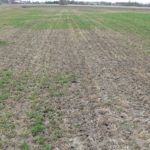
Winterkill!
Check your alfalfa stands! Winterkill and winter injury are being reported across much the province, including many areas in western and central Ontario where winterkill is not normally an issue. Many stands are showing extensive damage. Forage crop green-up and growth has been delayed about 2 weeks by cool weather, particularly fields that were fall cut. This has delayed the diagnosis of winter injury, and the full level of damage is still unknown in some areas. Wet soil conditions have also delayed the progress of new seedings, with only a small percentage in the ground. Fortunately, spring carry-over forage inventories are generally good, with the exception of high quality hay.
Risk Factors
Alfalfa winterkill is more common in older stands, flat heavier clays, and fall harvested stands, but also includes some new seedings, as well as orchardgrass. Even some of the better fields have a small amount of damage in low spots. Cumulative management stresses worsening the situation include late-fall cutting, poor soil fertility and pH, lack of potato leafhopper management (2012), and traffic damage from manure tankers. Environmental risk factors include the wet late-fall that reduced winter hardening, water ponding and icing, extreme cold temperatures, and crown and root disease. Winterkill in the Ottawa Valley is below normal, except for areas along the St Lawrence which have up to 80% winterkill.
Diagnosis & Decision Making
There is nothing worse than having cattle to feed and then being caught off guard by low forage yields! To ensure adequate forage to feed livestock this coming year, walk alfalfa stands, dig some plants and use a knife to cut open the root and crown to assess for plant health. Make decisions based on yield potential on a field-by-field basis. Watch for crown and root rots, brownish disclouration, spongy texture, a lack of secondary roots and nodulation, and assymetrical crowns. Plant health can be more significant than plant density to a successful yield. The minimum number of healthy plants per square foot should be 12 – 20 for 1st year stand, 8 – 12 plants for 2nd year stands and 5 plants for a 3rd year or older stand. This cannot wait until after the corn is planted, since dealing with winterkilled forage stands may alter the crop rotation significantly. Refer to “Check Alfalfa Stands This Spring and Make A Plan” https://fieldcropnews.com/?p=5845 .
Options
If early enough, the best option is often to replace the winterkilled stand by seeding a new forage stand in a new field in the crop rotation. Corn can follow the winterkilled alfalfa to take advantage of the 100 lbs/ac nitrogen credit and 10 – 15% rotational yield benefit. A direct seeding can be done, or by using a companion forage crop such as cereals or cereal-pea mixtures. (Forage Production From Spring Cereals and Cereal-Pea Mixtures http://www.omafra.gov.on.ca/english/crops/facts/98-041.htm) Where winterkilled areas are large and patchy, some farmers attempt to repair these areas by no-tilling in red clover and / or Italian ryegrass. These species are difficult to dry for hay, but can make quality haylage. If an alfalfa stand is uniformly thin or weakened but the grass content is good, an application of nitrogen can significant increase yields and increase protein levels. (Apply Nitrogen To Grass Stands To Increase Yields https://fieldcropnews.com/?p=6830 ) Do not try to repair a stand by interseeding alfalfa into an alfalfa stand because of autotoxicity and disease, unless the stand was seeded the preceding year.
Frost Heaving
There has also been some frost heaving of alfalfa reported. Assuming otherwise healthy plants, if the crowns are heaved less than 1 inch, the taproot is probably not broken and the stand is salvageable. These stands will likely reseat themselves over the season by natural settling and secondary root growth. Do not cultipack these fields, as this does more damage than good by damaging crowns. If crowns are heaved more than 1 inch, the taproot is likely broken. Broken plants will green up, but then die, depending on how deep the break is. Refer to “Frost Heaving of Alfalfa” https://fieldcropnews.com/?p=6344